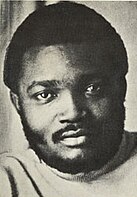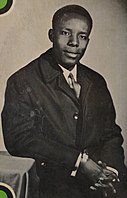Soukous
| Soukous | |
|---|---|
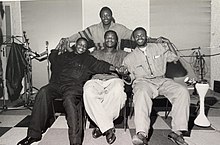 | |
| Stylistic origins | |
| Cultural origins | Late 1960s inDRCandRepublic of the Congo,1980s inFrance |
| Derivative forms | Muziki wa dansiandndombolo |
| Regional scenes | |
| Congolese sound (Kenya,Uganda,Tanzania), fast-paced soukous (Paris) | |
| Other topics | |
| Soukous musicians | |
Soukous(fromFrenchsecousse,"shock, jolt, jerk" ) is a genre ofdance musicoriginating from theDemocratic Republic of the Congo(formerlyZaire) and theRepublic of the Congo(formerlyFrench Congo).[1]It derived fromCongolese rumbain the 1960s, with faster dance rhythms and bright, intricateguitar improvisation,[2]and gained popularity in the 1980s inFrance.[3]Although often used by journalists as a synonym for Congolese rumba, both the music and dance associated with soukous differ from more traditional rumba, especially in its higher tempo, song structures and longer dance sequences.[3]
Soukous fuses traditional Congolese rhythms with contemporary instruments. It customarily incorporateselectric guitars,double bass,congas,clips, a third guitar (mi-solo), andbrass/woodwinds.[4][5]Soukous lyrics often explore themes oflove,social commentary,amorous narratives,philosophical musings, and ordinarystrugglesandsuccesses.[2]Singers occasionally sing and croon inLingala,Kikongo,FrenchandSwahiliand bands often consist of a primary vocalist accompanied by severalbacking singers.[6][7]
Musical form
[edit]The basic line-up for a soukous band included three or four guitars,bass guitar,drums,brass,andvocals.[8]The musical arrangement begins with arumbasection characterized by intricateharmony.As the song transitions into its mid-tempo and concluding rapid segments, harmonic structures often simplify to atriadic chordalprogression.[9]InMatonge,the rhythmic guitar typically accompanies mid-tempo vocal passages, with thebassandbass drumsaccentuating strong beats, while guitarists emphasize the offbeats (oneandtwoandthreeandfourand).[9]
The percussive section frequently employs a relentless, rapid rhythm known ascavacha,which serves as the song's rhythmic foundation.[10]Franco Luambonotably popularized the placement of thesébèneat the conclusion of a song, employing a thumb-and-forefinger picking technique that creates the auditory illusion of dual guitar lines.[11]During the sébène, the drummer signals transitions, guiding the guitarists to shift their parts synchronously with the lead player. The conventional Congolese progression for the sébène follows the I-IV-V-IV chord sequence. Collaborative interplay with fellow guitarists and the drummer enhances technical proficiency.[9]Soukousbass lines,inspired byhand-drumpercussion patterns, significantly contribute to the rhythmic and harmonic texture of the music. Emerging prominently duringMobutu Sese Seko's regime inZaire,the assertive bass style of soukous emulated the movements of soldiers, known asmarche militaire.This distinctive bass approach involves toggling between lower and higherregisters,utilizing a picking technique with the thumb (p) and index finger (i).[9]
During vocal performances, thelead guitaristestablishes agroovethat supports harmonizedcall-and-responsevocals,[9]often enhanced by an echo effect, creating a sometimes described hypnotic auditory experience. The music typically utilizes a 12/8time signatureandmajor chordsarticulated inarpeggiatedforms.[10]Soukous lead guitarists are renowned for their speed, precision, and nimble fingerwork, often navigating the higherregistersof thefretboard.[9]
History
[edit]Origins
[edit]The origins of the genre can be traced back toCongolese rumba,which emerged in the early 20th century when urban residents of theFrench Congoand theBelgian Congoembraced the fusion of intertribalKongolesemaringadance music nearPool Malebo,infused with guitar techniques fromLiberia.[12]The outflow ofKrumerchantsand sailors from Liberia toBrazzavilleduring the mid-19th century introduced distinctive guitar-playing techniques that ultimately influenced the use of theaccordionto emulate local "likembe"(thumb piano, best known worldwide as ambira) rhythms.[12][13]As early as 1902, the accordion's melodies resonated through the streets near Pool Malebo's factories.[12]

The outbreak ofWorld War Iintroduced a new wave of music and dance across theLower Congo(present-dayKongo Central) and thePool Maleboregion.[12]Emerging fromlabor campand conceivably associated with the return ofMatadi–Kinshasa Railwayconstruction workers, local dances such as agbaya and maringa gained prominence.[12]Thecircularagbaya dance was soon replaced bypartneredmaringa dance music, becoming increasingly ubiquitous inMatadi,Boma,Brazzaville,and Léopoldville (nowKinshasa).[12] Initially, maringa bands featured thelikembeformelody,a metal rod-struck bottle for rhythm, and a small skin-coveredframe drumcalledpatengeforcounter-rhythms.[12]However, by the 1920s, accordions andacoustic guitarsprogressively supplanted thelikembeas melody instruments. The distinctive hip movements ofmaringadancers, shifting their body weight between legs gained popularity.[12]By 1935, partnered dancing's popularity dispersed expeditiously across theCongo basin,reaching even remote villages. Dance halls emerged in towns and rural areas, while conventional dancing persisted in palm branch huts.[12]

In the early 1940s, Pool Malebo transformed from a barrier into a communication channel linking Brazzaville and Kinshasa.[12]TheCuban songroups likeSexteto Habanero,Trio Matamoros,and Los Guaracheros de Oriente were broadcast onRadio Congo Belge,gaining popularity in the country.[12][14][15]Due to influence of Cuban son, the maringa dance music—although unrelated toCuban rumba—became known as "rumba Congolaise"as the imported records ofSexteto HabaneroandTrio Matamoroswere often mislabeled as "rumba".[16][12][17]Ethnomusicology Professor Kazadi wa Mukuna ofKent State Universityexplicates that the term "rumba" persisted in the Congos due to recording industry interests. Recording studio proprietors reinterpreted the term rumba by attributing it newmaringarhythm while retaining the name.[16]Consequently, their music became recognized as "Congolese rumba" or "African rumba".Antoine Wendo Kolosoybecame the first star of Congolese rumba touringEuropeandNorth Americawith his band Victoria Bakolo Miziki. His 1948 hit "Marie-Louise," co-written with guitaristHenri Bowane,gained popularity acrossWest Africa.[18][19]Congolese rumba gained prominence inCongolese musicas early pioneers revolutionized their relationship with the instruments they held.[20][21]
Formation and paternity debate
[edit]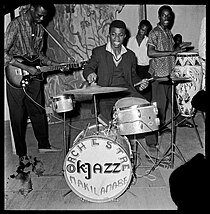
Etymologically, the termsoukous,derived from the French verbsecouer,denoting "to shake," initially described a person who moved jerkily but evolved into a dance style synonymous with vitality and cadence.[22]The termsecousseevolved over time, transitioning tosoucoussesand eventuallysoucousincolloquial languageand the media, until the "c"fell out of favor, replaced by a"k".[22]
During the early 1960s, a surge of young Congolese musicians sought to speed up the slow tempo of Congolese rumba, which precipitated the emergence of soukous. Artists began incorporating faster rhythms, and prominent guitar improvisation, often characterized by high-pitched, fast-paced lines imbued with more heightened Africanmotif.The drummer shifts to the high-octane cadence, wherein theclave rhythmshifts to thesnare drum,singers engage in rhythmic chanting (animation), and lead guitars take center stage.[23][2][24][11]
The origins of soukous are a matter of dispute, with divergent attributions and viewpoints. Clément Ossinondé, a Congolese musicologist specializing in Congolese music, accreditsFranco LuamboandTPOK Jazzwith pioneering soukous, citing hisodemba-inspired style, known for its fast tempo.[25]Franco is also recognized for revolutionizing the genre's themes by infusing significantsocialandpoliticalissues into the lyrics, making the music a platform forsocial consciousness.[23][2][24][11]Conversely, British writer Gary Stewart suggests that soukous evolved into both a music genre and dance style in Brazzaville, stemming from the establishment of the Super Band in 1964 by up-and-coming guitarist Jacques Kimbembe.[26]The ensemble, later rebranded as Sinza, meaning "root stock," introduced soukous to Brazzaville's nightlife in 1966, supplanting the traditional boucher style of Les Bantous de la Capitale.[26]Stewart further notes that Orchestre Sinza innovated soukous in 1968 with a new wrinkle calledmossaka,and soon thereafter,Nico Kasandaintroduced the kiri-kiri, which was based in part on the "jerk" fromWestern rock.[26]Meanwhile, Les Bantous de la Capitale developed a fusion with Pablito's song "Masuwa," billed as asoucous-kiri-kiri.The kiri-kiri, which, according to Stewart, became a defining piece of the genre as exemplified by Nico's "Kiri-Kiri Mabina Ya Sika," telling the story of a man's quest through Kinshasa's streets to reunite with his partner for a kiri-kiri session at Fiesta Sukisa, gaining widespread acclaim.[26]Established artists rapidly embraced the dance and disseminated it across the continent.[27]
1960s and 1970s
[edit]Europe and the United States
[edit]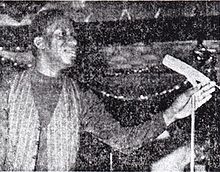
In the late 1960s and early 1970s, soukous became a predominant popular African dance style across Africa and into the continent's diaspora in Belgium, France, the UK, and the United States.[28][29]During this period, a surge of Zairean musicians moved to Belgium and France, primarily driven by the hegemony of theMobutu Sese Sekoregime, which propagated propaganda songs as part of theAuthenticitécampaign to foster a sense of national identity and pride through ideological slogans of theone-party state,theMovement Populaire de la Révolution(MPR).[30][31][32]Thisstate ideologicalshift gradually infiltrated Zairean popular music, with popular musicians embracing the regime's ideology and documenting its achievements. Mobutu's encouragement of urban musicians paralleledMao Zedong's approach inChina,where music served the revolution.[33][31][34]As a result, theglobalizationof Congolese urban music expanded, leading to a massive exodus of musicians to African and European countries, most notablyBelgiumandFrance.[33][35]Many youths with limited employment options gravitated towards a music career, with Kinshasa's soukous scene becoming an attractive choice. However, some faced obstacles in establishing themselves in France.[16][36][28]Against this backdrop,Tabu Ley Rochereaumade history as the first African artist invited to perform at Paris'sOlympia Hallin December 1970, where he attracted few connoisseurs and set a precedent for subsequent Zairean musicians.[28][37][38][39]Abeti Masikinifollowed suit, becoming the second Zairean and the first female soukous artist to grace the Olympia stage alongsideMireille MathieuandHugues Aufray.[40][41][42]This momentum continued with Masikini's performance atCarnegie HallinNew Yorkon 11 March 1974, setting the stage for burgeoning singers,griots,and other lesser-known divas from Africa.[28][43]
Concurrently, the M'Bamina orchestra ventured to Paris before seeking audiences inItalyin 1972.[28]Pablo 'Porthos' Lubadika arrived in Paris in 1979 with singerSam MangwanathroughLomé,Togo,after recording under the name the African All Stars. Mangwana, having collaborated with nearly every prominent figure in Congo, relocated toAbidjanin 1978 to pursue better opportunities. He formed a new band of Congolese economic exiles, who became regulars in Parisian session bands.[44]The African All Stars' breakout hit, "Suzana Coulibaly," released on December 31, 1979, featured "simple, repetitive rhythms" at a faster tempo than traditional Congolese rumba.[44]Mangwana's exclamation "soukous sophistiqué" as Lokassa Ya M'Bongo andRigo Starcrafted a "rock-solid" sebene solidified the record's direction, initiating an independent musical movement targeting the international market. As their influence grew, the African All Stars adapted the fast, rough stylings of youth bands in Brazzaville and Kinshasa, introducing this new tempo globally.[44]
Africa
[edit]Across Africa, soukous dominatedEast Africannightclubs' dance floors and played a pivotal role in shaping virtually all the styles of contemporaryAfrican popular music,includingbenga music,muziki wa dansi,Kidandali,Igbo highlife,palm-wine music,taarab,and inspiring the establishment of approximately 350 youth orchestras in Kinshasa, paving the way for new traditional dances, rhythmic patterns, and bands.[45][46][11][47]

As sociopolitical turmoil in Zaire deteriorated in the 1970s, a great number of musicians ventured toTanzania,KenyaandUganda,where orchestras sustained themselves through record sales and consistent stage performances. By the early 1970s, several Congolese bands had taken up the soukous beat in Kenyan nightclubs.[48][49][50][51][52]The vivaciouscavachadance craze, propagated by bands likeZaïko Langa Langaand Orchestra Shama Shama, swept across East andCentral Africa,exert influence on Kenyan musicians.[53]The utilization of the cavacha rhythm, typically played on thesnare drumorhigh-hat,became emblematic of the Zairean sound inNairobiand was frequently adopted by regional bands. Prominent Congolese rumbaSwahilibands in Nairobi formed aroundTanzaniangroups likeSimba Wanyika,giving rise to offshoots likeLes Wanyikaand Super Wanyika Stars.[45][54][49]Maroon Commandos,a Nairobi-based ensemble, assimilated the soukous style while infusing their distinctive artistic imprint.Japanesestudents in Kenya, including Rio Nakagawa, developed a fondness for Congolese music, with Rio eventually spearheading Yoka Choc Nippon, a Japanese-conceived Congolese rumba group.[55]
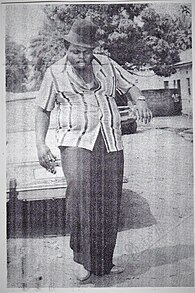
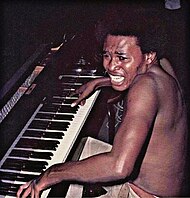
Virgin Records produced albums by the Tanzanian-ZaireanOrchestra Makassyand the Kenya-basedOrchestra Super Mazembe.The Swahili song "Shauri Yako" ( "It's your problem" ) gained widespread acclaim in Kenya, Tanzania, and Uganda. Another influential Zairean ensemble,Les Mangelepa,relocated to Kenya and achieved immense popularity across East Africa. Zairean singerSamba Mapangalaand his band Orchestra Virunga, based in Nairobi, released theLPMalako,which became a pioneering release in Europe's emerging world music scene.[56][57][58]Meanwhile, between 1976 and 1977,Sam Mangwanaand the African All Stars dominated the dance halls of Kinshasa with records produced inWest Africa,which were different from the sounds produced in the two-track studios of Kinshasa. Following this, there was a migration toLoméandCotonou,followed by Franco Luambo's departure to Belgium.[28]
InNigeria,soukous became widespread due to the transmission of Zairean music through Radio Brazzaville, where audiences were introduced to material fromZaire Vol. 6(Soundpoint SOP 044, 1978).[59][60]Soukous catalyzed the emergence of a distinct genre of guitar-basedIgbo highlifemusic, exemplified by musicians likeOliver De Coque,theOriental Brothers International,and their various imitators and followers.[59][61][62][63]The superabundance of Nigerian pressings of Zairean music featured the musicians who influenced this trend, as seen in the case ofMusic From Zaire Vol. 6,which showcased artists fromVerckys Kiamuangana Mateta's stable like Orchestre Kiam, Orchestre Lipua-Lipua, and the cavacha rhythm.[59]There was a prevalent inclination to exclude the slower "A" sides of various recordings and instead focus on the climacticsebene,the faster and more improvisationalsecond half.[59]This structural paradigm became emblematic of Igbo guitar highlife recordings epitomized by the music style of Oliver De Coque and Oriental Brothers International.[59]
Colombia
[edit]During this epoch, African music began procuring popularity globally due to the world music movement. InColombia,soukous gained traction, influencing local culture and playing a pivotal role in pioneeringchampeta.[64][65]Zairean sailors introduced their records to Colombia, including the plate-numbered 45 RPM "El Mambote" by Congo's l'Orchestre Veve, which gained popularity.[52]The locals began replicating musical arrangements by Congolese luminaries likeNicolas Kasanda wa Mikalay,Tabu Ley Rochereau,M'bilia Bel,Syran Mbenza,Lokassa Ya M'Bongo,Pépé Kallé,Rémy Sahlomon, andKanda Bongo Man.Homegrown talents like Viviano Torres, Luis Towers, and Charles King added their original compositions to the mix, maintaining the core essence of Congolese soukous.[51][66][52]
1980s and the Paris scene
[edit]
As sociopolitical unrest persisted in Zaire throughout the 1980s, numerous musicians sought refuge across Africa, with a considerable number relocating to Belgium, France, and the United Kingdom. Some traversed through Central and East Africa before ultimately establishing their operational bases in Europe.[67][68][69][70][71]Soukous gained traction in Brussels, Paris, and London, emerging as the only sub-Saharan African genre universally embraced in Belgium and France.[72]According to Congolese columnistAchille Ngoye,Belgium offered a significant permanent operational base for numerous Zairean artists.[28]Orchestras such as Los Nickelos, Yéyé National, and Les Mongali, predominantly composed of students, garnered significant attention in Belgium.[28][73][74]Uncle Yorgho, a former member ofOK Jazz,established a distribution epicenter for Zairean musical repertoire in Brussels in July 1980 (Visa 80).[28]Meanwhile,Dieudonné Kabongo,Dizzy Mandjeku, andNtesa Dalienstrose to prominence due to the bankruptcy of Belgian record label Fonior!, which prompted many Zairean artists likeLita Bemboand Matima to seek reputable distribution entities in Belgium, while others found solace in performing in religious choirs, which frequently touredHolland.[28]

Soukous was chosen byIsland RecordsproducerBen Mandelsonand Togolese entrepreneur Richard Dick as the title of a 1982 compilation,Sound D'Afrique II: Soukous.The compilation included music fromMaliandCameroonalongside "Madeleina," a track from Pablo 'Porthos' Lubadika's 1981 albumMa Coco,which gained significant attention in Europe.[75]Zaïko Langa Langa introduced the role of a dedicated hypeman—known asatalakuor animateur—into the ensemble of singers, setting a trend that almost every band on the Congolese music scene adopted, making animators emblematic of soukous as well as Congolese rumba.[75]Zaïko Langa Langa achieved significant success, becoming the third generation of Congolese music as many founding members split off to form their own groups, which in turn splintered into more groups:Isife Lokole,Grand Zaïko Wa Wa, Langa Langa Stars, Clan Langa Langa,Choc Stars,and Anti-Choc among them.[75][76]Papa WembaandViva La Musicamade the longest-lasting impact, partly due to Wemba's ability to maintain a presence in both Paris and Kinshasa with dual bands, one focusing on soukous and another featuring French session players for international pop. In Parisian studios, the seben guitars blended with the tight drum machines and synths ofzoukand funky discomakossaon numerous records.[75][77][78]However, this fusion received criticism for deviating from authentic Congolese styles. Notable critics likeNybomaargued that the music had become commercialized and lacked emotional depth, calling for a return to the fundamentals of "beautiful melodies and highly tuned voices."[79]: 384–385 [80]
The influx of Zairean artists to France catalyzed the proliferation of Parisian studios as epicenters for soukous production, with an increasing reliance on synthesizers andelectronic instruments.Some artists continued to record for the Congolese market, but others abandoned the demands of the Kinshasa public and set out to pursue new audiences.[77][28][78]A sizable Zairean community established itself in France andSwitzerland,with Zairean artists conducting training programs in the country.[28]Kanda Bongo Man,another Paris-based artist, pioneered fast, short tracks conducive for play on dance floors worldwide, popularly known askwassa kwassa,after the dance moves popularized in his and other artists' music videos. This music appealed to Africans and to new audiences as well. Artists likeDiblo Dibala,Aurlus Mabélé,Tchicl Tchicaya, Jeannot Bel Musumbu,M'bilia Bel,Yondo Sister,Tinderwet,Loketo,Rigo Star, Nyboma,Madilu System,Soukous Stars and veterans likePépé KalléandKoffi Olomidéfollowed suit. Soon Paris became home to talented studio musicians who recorded for the African and Caribbean markets and filled out bands for occasional tours.[48][81]Diblo Dibala and Aurlus Mabélé dominated the clubs with "Africa Moussou", creating a hyperactive style of super-speed soukous, dubbedTGV soukousby fans, alluding to France's high-speed trains.[75]
Swede-Swede, an ensemble exclusively employing traditional instruments, operates out of Belgium, while Les Malo, primarily comprising former instructors from theNational Institute of Artsin Kinshasa, specializes in Afro-jazz inLyon.[28]Tshala Muanagained prominence in Africa and Europe for herLubatraditional hip-swaying dance known asmutuashi,which make waves across African stadiums and earned her the moniker of "Queen of Mutuashi".[28]Other female vocalists such as Déesse Mukangi, Djena Mandako, Faya Tess, Isa, and Abby Surya garnered widespread recognition.[28]
Ndombolo
[edit]By the late 1990s, musicians such as Radja Kula,Wenge Musica,Koffi Olomidé,Général Defao,andExtra Musicametamorphosed soukous into raunchy, frenetic hip-swinging dance music, renaming itndombolo.[82][83][84][85][86]This style surged in popularity across Africa and into the continent's diaspora in Belgium, France, the UK, Germany, Canada, and the United States.[87][88][89]However, by the early 2000s, ndombolo faced scrutiny, with accusations ofobscenityleading to attempts to prohibit it from state media in the Democratic Republic of the Congo,Cameroon,Senegal,Mali,andKenya.[90][91][92][93]In February 2005, ndombolo music videos in the Democratic Republic of the Congo underwent censorship for indecency, which resulted in the banning of videos by Koffi Olomidé, JB MPiana, andWerrasonfrom airwaves.[94]Despite the censure, ndombolo record sales surged, remaining popular with new releases dominating discos, bars, and clubs across Africa.[95]
See also
[edit]- List of Soukous musicians
- Music of the Democratic Republic of the Congo
- Musicians from the Democratic Republic of the Congo
- Champeta
- Calypso
- Marrabenta
- Sébène
References
[edit]- ^Appiah, Anthony; Gates, Henry Louis (2010).Encyclopedia of Africa, Volume 1.Oxford, UK: Oxford University Press. pp. 407–408.ISBN9780195337709.
- ^abcdAppiah, Anthony; Gates (Jr.), Henry Louis (2010).Encyclopedia of Africa.Oxford, United Kingdom: Oxford University Press. pp. 407–408.ISBN978-0-19-533770-9.
- ^abPeek, Philip M.; Yankah, Kwesi (2004).African Folklore: An Encyclopedia.New York, NY: Routledge. p. 548.ISBN9781135948733.
- ^Davies, Carole Boyce (July 29, 2008).Encyclopedia of the African Diaspora [3 volumes]: Origins, Experiences, and Culture [3 volumes].Santa Barbara, California: Bloomsbury Publishing USA. p. 849.ISBN978-1-85109-705-0.
- ^Domosh, Mona; Jordan-Bychkov, Terry G.; Neumann, Roderick P.; Price, Patricia L. (2012).The Human Mosaic.Macmillan. p. 416.ISBN978-1-4292-7200-1.
- ^Olwig, Karen Fog; Sorensen, Ninna Nyberg (August 27, 2003).Work and Migration: Life and Livelihoods in a Globalizing World.Oxfordshire, England, United Kingdom: Routledge. p. 56.ISBN978-1-134-50306-3.
- ^Russell, K.F. (1997).Rhythm Music Magazine: RMM.K.F. Russell. p. 45.
- ^Boomer, Tim; Berry, Mick; Bufe, Chaz (January 1, 2014).Bassist's Bible: How to Play Every Bass Style from Afro-Cuban to Zydeco.See Sharp Press.ISBN978-1-937276-25-6.
- ^abcdefEyre, Banning (2002).Africa: Your Passport to a New World of Music.Los Angeles, California, United States: Alfred Music Publishing. pp. 12–17.ISBN978-0-7390-2474-4.
- ^abGreenstreet, Morgan (December 7, 2018)."Seben Heaven: The Roots of Soukous".Daily.redbullmusicacademy.RetrievedJune 11,2024.
- ^abcdAfrican, New (August 15, 2018)."The mixed legacy of DRC musician Franco".New African Magazine.RetrievedAugust 26,2023.
- ^abcdefghijklMartin, Phyllis (August 8, 2002).Leisure and Society in Colonial Brazzaville.Cambridge, United Kingdom: Cambridge University Press. pp. 131–152.ISBN978-0-521-52446-9.
- ^Kubik, Gerhard (October 30, 2010).Theory of African Music, Volume I.Chicago, Illinois, United States: University of Chicago Press. pp. 384–385.ISBN978-0-226-45691-1.
- ^The Encyclopedia of Africa v. 1.2010 p. 407.
- ^Storm Roberts, John (1999).The Latin Tinge: The Impact of Latin American Music on the United States(2nd ed.). New York, NY: Oxford University Press. pp.217–218.ISBN978-0-19-976148-7.
- ^abcMukuna, Kazadi wa (December 7, 2014)."A brief history of popular music in DRC".Music In Africa.RetrievedAugust 25,2023.
- ^Edward-Ekpu, Uwagbale (December 21, 2021)."Rumba's Congolese roots are finally being recognized by Unesco".Quartz.RetrievedAugust 27,2023.
- ^"Les années 1970: L'âge d'or de la musique congolaise"[The 1970s: The Golden Age of Congolese Music].Mbokamosika(in French). August 18, 2009.RetrievedAugust 26,2023.
- ^"'Father' of Congolese rumba dies ".BBC.July 30, 2008.RetrievedAugust 26,2023.
- ^Greenstreet, Morgan (December 7, 2018)."Seben Heaven: The Roots of Soukous".daily.redbullmusicacademy.RetrievedAugust 26,2023.
- ^Ossinonde, Clément (August 2, 2017)."Qui est à l'origine du" Sebene "dans la musique congolaise? Sa notation musicale?".Pagesafrik(in French).RetrievedAugust 26,2023.
- ^abStewart, Gary (May 5, 2020).Rumba on the River: A History of the Popular Music of the Two Congos.Brooklyn, New York, New York State, United States: Verso Books.ISBN978-1-78960-911-0.
- ^abAP (1989)."Franco, 51, Zairian Band Leader And Creator of the Soukous Style".The New York Times.RetrievedNovember 18,2022.
- ^abAppiah, Anthony; Gates (Jr.), Henry Louis (2010).Encyclopedia of Africa.Oxford, United Kingdom: Oxford University Press. p. 407.ISBN978-0-19-533770-9.
- ^Ossinondé, Clément (March 2, 2020)."Voyage Musical: l'aller et retour de la rumba"[Musical Journey: the back and forth of the rumba].Congopage(in French).RetrievedOctober 28,2023.
- ^abcdStewart, Gary (May 5, 2020).Rumba on the River: A History of the Popular Music of the Two Congos.Brooklyn, New York, New York State, United States: Verso Books.ISBN978-1-78960-911-0.
- ^Greenstreet, Morgan (December 7, 2018)."Seben Heaven: The Roots of Soukous".Daily.redbullmusicacademy.RetrievedJune 11,2024.
- ^abcdefghijklmnoNgoye, Achille (1995)."Le soukouss des Zaïrois en Europe".Hommes & Migrations.1191(1): 42–47.doi:10.3406/homig.1995.2536.
- ^Winders, James A. (June 5, 2007).Paris Africain: Rhythms of the African Diaspora.New York, New York State, United States: Palgrave Macmillan US. p. 57.ISBN978-0-230-60207-6.
- ^Ndaliko, Chérie Rivers (March 2020)."Mobutu's Ghost: A Case for the Urgency of History in Cultural Aid".academic.oup.Oxford, England, United Kingdom.RetrievedMay 11,2024.
- ^abSturman, Janet, ed. (February 26, 2019).The SAGE International Encyclopedia of Music and Culture.Thousand Oaks, California, United States: SAGE Publications.ISBN978-1-5063-5337-1.
- ^Appiah, Anthony; Gates, Henry Louis, eds. (2005).Africana: The Encyclopedia of the African and African American Experience.Oxford, England, United Kingdom: Oxford University Press. p. 201.ISBN978-0-19-517055-9.
- ^abWa Mukuna, Kazadi (December 7, 2014)."A brief history of popular music in DRC".Music In Africa.RetrievedMay 13,2024.
- ^Jean-Jacques, Daniel; Falola, Toyin, eds. (December 14, 2015).Africa: An Encyclopedia of Culture and Society [3 volumes].Santa Barbara, California, United States: ABC-CLIO. p. 301.ISBN978-1-59884-666-9.
- ^Perullo, Alex (2008)."Rumba in the City of Peace: Migration and the Cultural Commodity of Congolese Music in Dar es Salaam, 1968-1985".Ethnomusicology.52(2): 296–323.doi:10.2307/20174590.ISSN0014-1836.JSTOR20174590.
- ^Rand, Jonas (December 17, 2016)."Congolese Music, 1970s".From the Sahel to the Cape.RetrievedMay 11,2024.
- ^White, Bob W. (June 6, 2008).Rumba Rules: The Politics of Dance Music in Mobutu's Zaire.Durham, North Carolina, United States: Duke University Press. p. 114.ISBN978-0-8223-8926-2.
- ^Africa Events: Volume 1.Dar es Salaam, Dar es Salaam Region, Tanzania: Dar es Salaam Limited. 1985. pp. 60–61.
- ^Barlow, Sean; Eyre, Banning; Vartoogian, Jack (1995).Afropop!: An Illustrated Guide to Contemporary African Music.New York, New York State, United States: Chartwell Books. p. 28.ISBN978-0-7858-0443-7.
- ^"musicMe: Biographie de Abeti Maskini".musicMe(in French). Paris, France.RetrievedNovember 14,2023.
- ^"Abeti Masikini Finant Elisabeth 1954 -1994".Universrumbacongolaise(in French). June 19, 2012.RetrievedNovember 17,2023.
- ^Bergman, Billy (1985).African Pop: Goodtime Kings.Blandford. p. 51.ISBN978-0-7137-1551-4.
- ^Fraser, C. Gerald (March 11, 1974)."African Singer, Too, Got A Start in Church Choir".The New York Times.ISSN0362-4331.RetrievedNovember 16,2023.
- ^abcGreenstreet, Morgan (December 7, 2018)."Seben Heaven: The Roots of Soukous".Daily.redbullmusicacademy.RetrievedJune 11,2024.
- ^abStone, Ruth M., ed. (April 2, 2010).The Garland Handbook of African Music.Thames, Oxfordshire United Kingdom: Taylor & Francis. pp. 132–133.ISBN9781135900014.
- ^Messager (August 18, 2009)."Les années 1970: L'âge d'or de la musique congolaise".Mbokamosika(in French).RetrievedAugust 27,2023.
- ^Sturman, Janet (February 26, 2019).The SAGE International Encyclopedia of Music and Culture.Thousand Oaks, California, United States: SAGE Publications.ISBN978-1-5063-5338-8.
- ^abDavies, Carole Boyce (July 29, 2008).Encyclopedia of the African Diaspora [3 volumes]: Origins, Experiences, and Culture.New York City, New York State, United States: Bloomsbury Publishing USA. p. 849.ISBN978-1-85109-705-0.
- ^abTrillo, Richard (2016).The Rough Guide to Kenya.London, United Kingdom: Rough Guides. p. 598.ISBN9781848369733.
- ^Stewart, Gary (May 5, 2020).Rumba on the River: A History of the Popular Music of the Two Congos.Brooklyn, New York City, New York State: Verso Books.ISBN978-1-78960-911-0.
- ^abValdés, Vanessa K., ed. (June 2012).Let Spirit Speak!: Cultural Journeys Through the African Diaspora.Albany, New York City, New York State: State University of New York Press. pp. 40–41.ISBN9781438442174.
- ^abcHodgkinson, Will (July 8, 2010)."How African music made it big in Colombia".The Guardian.ISSN0261-3077.RetrievedAugust 23,2023.
- ^Adieu, Verckys (October 19, 2022)."congolese rumba".Cavacha Express! Classic congolese hits.RetrievedAugust 27,2023.
- ^"congolese rumba".Cavacha Express! Classic congolese hits.October 19, 2022.RetrievedJuly 10,2023.
- ^Mwamba, Bibi (February 7, 2022)."L'influence de la rumba congolaise sur la scène musicale mondiale".Music in Africa(in French).RetrievedAugust 23,2023.
- ^"Shauri Yako — Orchestra Super Mazembe".Last.fm.RetrievedJuly 10,2023.
- ^"congo in kenya".muzikifan.RetrievedJuly 10,2023.
- ^Nyanga, Caroline."Stars who came for music and found eternal resting place".The Standard.RetrievedJuly 10,2023.
- ^abcdeBeadle, John (August 18, 2010)."From Congo via Nigeria".Likembe.Milwaukee, Wisconsin, United States.RetrievedMay 12,2024.
- ^"Various – Music From Zaire Vol. 6".Discogs.Beaverton, Oregon, United States. 1978.RetrievedMay 12,2024.
- ^"Google Honors Oliver de Coque with a Doodle on his 74th Posthumous Birthday".BellaNaija.Lagos, Nigeria. April 14, 2021.RetrievedMay 12,2024.
- ^Collins, John (1994).The Ghanaian Concert Party: African Popular Entertainment at the Cross Roads.Buffalo, New York State, United States: State University of New York at Buffalo. p. 47.
- ^The Beat: Volume 14.Melbourne, Australia: Beat Magazine. 1995. p. 41.
- ^Malandra, Ocean (December 2020).Moon Cartagena & Colombia's Caribbean Coast.New York City, New York State, United States: Avalon Publishing.ISBN9781640499416.
- ^Koskoff, Ellen, ed. (2008).The Concise Garland Encyclopedia of World Music: Africa; South America, Mexico, Central America, and the Caribbean; The United States and Canada; Europe; Oceania.Oxfordshire, England, United Kingdom: Routledge. p. 185.
- ^Slater, Russ (January 17, 2020)."Colombia's African Soul".Long Live Vinyl.RetrievedAugust 23,2023.
- ^Davies, Carole Boyce (July 29, 2008).Encyclopedia of the African Diaspora [3 volumes]: Origins, Experiences, and Culture.New York City, New York State, United States: Bloomsbury Publishing USA. p. 849.ISBN978-1-85109-705-0.
- ^Trillo, Richard (2016).The Rough Guide to Kenya.London, United Kingdom: Rough Guides. p. 598.ISBN9781848369733.
- ^Stewart, Gary (May 5, 2020).Rumba on the River: A History of the Popular Music of the Two Congos.Brooklyn, New York City, New York State: Verso Books.ISBN978-1-78960-911-0.
- ^Valdés, Vanessa K., ed. (June 2012).Let Spirit Speak!: Cultural Journeys Through the African Diaspora.Albany, New York City, New York State: State University of New York Press. pp. 40–41.ISBN9781438442174.
- ^Hodgkinson, Will (July 8, 2010)."How African music made it big in Colombia".The Guardian.ISSN0261-3077.RetrievedAugust 23,2023.
- ^Daoudi, Bouziane (August 29, 1998)."World. Le chanteur ex-zaïrois en concert à l'Olympia. Koffi Olomidé, Rambo de la rumba. Koffi Olomidé. Samedi à 23 heures à l'Olympia, 28, bd des Capucines, Paris IXe. Tél.: 01 47 42 25 49. Album:" Loi ", Sonodisc"[World. The ex-Zairian singer in concert at the Olympia. Koffi Olomidé, Rambo of rumba. Koffi Olomide. Saturday at 11 p.m. at the Olympia, 28, bd des Capucines, Paris 9th. Tel.: 01 47 42 25 49. Album: “Law”, Sonodisc.].Libération(in French). Paris, France.RetrievedDecember 29,2023.
- ^Mbu-Mputu, Norbert X.L'AUTRE LUMUMBA. Peuple du CONGO: Histoire, résistances, assassinats et victoires sur le front de la Guerre froide(in French). Morrisville, North Carolina, United States. p. 331.ISBN978-0-244-77422-6.
- ^Graham, Ronnie, ed. (1992).The World of African Music: Volume 1.London, England, United Kingdom: Pluto Press. p. 130.ISBN978-0-948390-03-6.
- ^abcdeGreenstreet, Morgan (December 7, 2018)."Seben Heaven: The Roots of Soukous".Daily.redbullmusicacademy.RetrievedJune 11,2024.
- ^Lavaine, Bertrand (September 30, 2020)."Zaïko Langa Langa, une histoire congolaise"[Zaïko Langa Langa, a Congolese story].RFI Musique(in French). Paris, France.RetrievedMay 27,2024.
- ^abStewart, Gary (May 5, 2020).Rumba on the River: A History of the Popular Music of the Two Congos.Brooklyn, New York City: Verso Books.ISBN978-1-78960-911-0.
- ^abVogel, Christoph; Network, part of the Guardian Africa (August 23, 2013)."Say my name: How 'shout-outs' keep Congolese musicians in the money".the Guardian.RetrievedAugust 27,2023.
- ^Stewart, Gary (2000).Rumba on the river: a history of the popular music of the two Congos.Verso.ISBN1-85984-744-7.
- ^Public Radio International, Afropop Worldwide, program on "The Four Stars," recorded February 1996 from KSKA Anchorage.
- ^"Kanda Bongo Man dances a new dance".BBC News.September 29, 2014.RetrievedAugust 27,2023.
- ^Ngaira, Amos (August 22, 2020)."Dancing styles innovator Radja Kula Mbuta takes last bow".Nation.RetrievedJanuary 13,2024.
- ^Mafuta, Masand (September 5, 2020)."Kinshasa: Gentiny Ngobila s'engage mordicus pour l'organisation des ob sắc ques de Radja Kula"[Kinshasa: Gentiny Ngobila is committed to organizing the funeral of Radja Kula].AxeNordSud Media(in French).RetrievedJanuary 13,2024.
- ^George, Nelson; Carr, Daphne (October 20, 2008).Best Music Writing 2008.New York City, New York State, United States: Hachette Books. p. 129.ISBN978-0-7867-2612-7.
- ^Buettner, Elizabeth (March 24, 2016).Europe after Empire: Decolonization, Society, and Culture.Cambridge, United Kingdom: Cambridge University Press. p. 313.ISBN978-1-316-59470-4.
- ^Makumeno, Emery (July 1, 2022)."Musique: qu'est-ce que le clan Wenge, pionnier de la danse Ndombolo?".BBC News Afrique(in French).RetrievedNovember 12,2023.
- ^George, Nelson; Carr, Daphne (October 20, 2008).Best Music Writing 2008.New York City, New York State, United States: Hachette Books. p. 129.ISBN978-0-7867-2612-7.
- ^Buettner, Elizabeth (March 24, 2016).Europe after Empire: Decolonization, Society, and Culture.Cambridge, United Kingdom: Cambridge University Press. p. 313.ISBN978-1-316-59470-4.
- ^Makumeno, Emery (July 1, 2022)."Musique: qu'est-ce que le clan Wenge, pionnier de la danse Ndombolo?".BBC News Afrique(in French).RetrievedNovember 12,2023.
- ^"Anger at Cameroon dance ban; BBC News",BBC News,July 25, 2000
- ^Falola, Toyin; Jean-Jacques, Daniel (December 14, 2015).Africa [3 volumes]: An Encyclopedia of Culture and Society [3 volumes].New York City, New York State, United States: Bloomsbury Publishing USA.ISBN979-8-216-04273-0.
- ^Trillo, Richard (2002).Kenya.London, England, United Kingdom: Rough Guides. p. 301.ISBN978-1-85828-859-8.
- ^Nzale, Félix (February 3, 2004)."Sénégal: Ndombolo, mapuka: ces danses jugées indésirables"[Senegal: Ndombolo, mapuka: these dances considered undesirable].Sudquotidien.sn(in French).RetrievedNovember 10,2023.
- ^Mutara, Eugene (April 29, 2008)."Rwanda: Memories Through Congolese Music".Newtimes.co.rw.RetrievedMay 12,2024.
- ^Woods, Sarah (July 6, 2017).The 50 Greatest Musical Places.North Road, London, United Kingdom: Icon Books.ISBN978-1-78578-190-2.
Bibliography
[edit]- Gary Stewart (2000).Rumba on the River: A History of the Popular Music of the Two Congos.Verso.ISBN1-85984-368-9.
- Wheeler, Jesse Samba (March 2005)."Rumba Lingala as Colonial Resistance".Image & Narrative(10). Archived fromthe originalon January 15, 2016.RetrievedJuly 14,2014.

